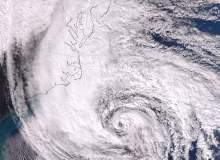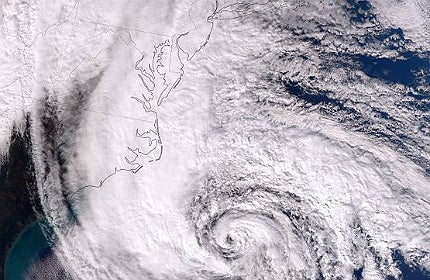
As Hurricane Sandy barrelled down on New York, contingency plans were already in action. Days before the storm made landfall, public transport was shut down, electrical grid equipment moved and hospital patients evacuated to safer ground. Such precautions indisputably saved lives and millions of dollars, but the window in which these precautions can be taken could be about to slam shut.

Discover B2B Marketing That Performs
Combine business intelligence and editorial excellence to reach engaged professionals across 36 leading media platforms.
Officials have been afforded this window of opportunity by the extensive coverage provided by a fleet of geostationary satellites that continually monitor meteorological developments in and around the US. The data recorded by these satellites shapes the accuracy of forecasts that have become vital during hurricane seasons that could, according to many scientists, become increasingly tempestuous.
The concern emanates from the rapidly deteriorating capabilities of these ageing satellites. Systems currently relied upon to contribute towards the accuracy of weather forecasting are approaching or have exceeded their maximum life expectancy. With the launch of the next replacement satellite having slipped to 2017, scientists fear the emergence of a coverage gap that could significantly hamper National Oceanic and Atmospheric Administration efforts to protect US civilians.
Current satellites in orbit
Although there are currently 90 Earth-sensing instruments carried aboard Nasa’s fleet of weather satellites, delays to the launch of the replacement Joint Polar Satellite System mean this figure could fall to as little as 20 by the turn of the decade, an event that NRC committee chairman Dennis Hartmann has labelled as having "profound consequences on science and society".
Hartmann’s damning indictment tends to be reinforced by statistics. Analysis of the cost of previous storms weighed against the expenditure of Nasa’s weather satellites shows that for every $1 invested into space infrastructure, $5 in clean-up costs are saved. What this fails to take into account, of course, is the price of human life – an invaluable quantity that detailed and accurate forecasting has undoubtedly saved in recent years.

US Tariffs are shifting - will you react or anticipate?
Don’t let policy changes catch you off guard. Stay proactive with real-time data and expert analysis.
By GlobalDataIncidents of extreme weather in recent years have professed to the efficacy of such satellites. Experiments with satellite data compiled during the blizzard that crippled Washington in 2010 demonstrated that forecasters would have underestimated the event by half without such data, whereas 84% of data used in American computer models to track Hurricane Sandy originated from polar satellites.
While this doesn’t prove beyond doubt that an entirely new and expensive fleet of weather-tracking satellites are an absolute necessity, it does demonstrate that the possible two-year coverage gap could potentially endanger lives.
Out with the old, in with the new
The realisation that such a coverage gap could occur has seen the replacement effort labelled as a "national embarrassment" by NOAA administrator Jane Lubchenco, triggering an urgent restructuring of the troubled and dysfunctional programme. Having been forced into an admission that replacement satellites could not be launched sooner, the US Government Accountability Office has labeled a coverage gap as "almost certain".
The $13bn programme has been placed under scrutiny, and was subsequently streamlined. Specific designs of JPSS components were nailed down, while immediate reports into how the agency intended to cope with the coverage gap were commissioned. While NOAA could feasibly compile data from alternative sources, such as military satellites, forecast reliability will still suffer and data reconfigured to be processed adequately.
JPSS satellites themselves incorporate a number of sensors and instruments to compile data, including a Visible Infrared Imaging Radiometer Suite, Cross-track Infrared Sounder, Advanced Technology Microwave Sounder, Ozone Mapper Profiler Suite and Clouds and Earth’s Radiant Energy System.
The compiled data is relayed to the JPSS Common Ground System, allowing NOAA meteorologists to put it through models to determine the threat posed by developing weather systems.
Whether repeated delays are due to negligence of complacency, the combination of increasing commonality of severe weather and a reduction in satellite coverage has created something of a perfect storm in itself. Forecasters will be forced to predict the implications of hurricanes with incomplete data, potentially endangering the lives of civilians. The window of opportunity could be blown in before people have the chance to board it up.
Related content
Is Nasa’s Space Fence the solution to space debris?
As Nasa scrambles to move the International Space Station out of harm’s way, efforts are being made to monitor space junk.
Winter focus – onboard with the latest bad weather systems
As winter tightens its grip across the northern hemisphere all eyes are on the latest in bad weather technology.




